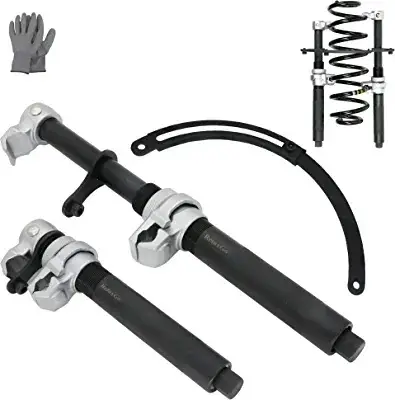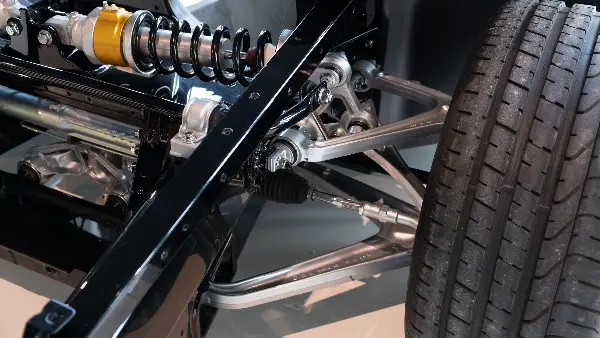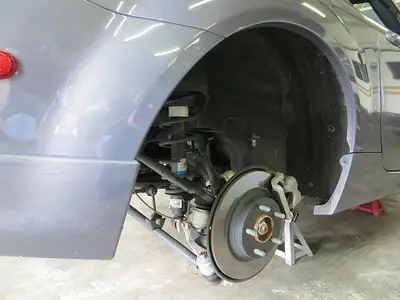Are you thinking about replacing your suspension setup? Then you must hear about three of the major players in the suspension section: MacPherson Strut, Double Wishbone, and Multilink Suspension. But what if MacPherson Strut vs. Double Wishbone vs. Multilink Suspension battling each other and making you confused?
The McPherson suspension system uses small struts, which building occupants locate more comfortably since the seats sit progressively higher alongside the increased vertical placement of these struts over the double-wishbone system.
Whilst double-wishbone suspension systems are used since they facilitate greater stability, the alignment of the shaft and wheel assemblies remains, at best, invariable. Recently, multi-link suspension systems have gained recognition among drivers due to the high traction they supply on roadways and the comfort their rides provide.
MacPherson Strut vs. Double Wishbone vs. Multilink Suspension
We all know that no matter what type of suspension we have, their primary job is the same which is absorbing impacts. However, there are not many common variables in comparing MacPherson Strut, Double Wishbone, and Multilink Suspension.
This is why we will present the core details of each suspension individually. All this information on one page will give you an instant overview. Let’s start.
1. MacPherson Strut Suspension

MacPherson strut is the most frequently employed suspension design in modern-day vehicles. It is a suspension style that is separated from other versions due to its simple design and compact size.
Because the MacPherson strut is usually utilized in front-wheel-drive vehicles, it is the primary choice for engineers and is employed in the majority of vehicles worldwide today.
Working Mechanism of MacPherson Strut
A MacPherson suspension system consists of two mounting points. One of which is the top bolt, which affixes the console to the vehicular body. The other part is the bottom mount that bolts the strut to the control arm.
Generally, the McPherson strut spring and damper enclosure is mounted vertically along the steering knuckle and comprises a compact cylinder containing the shock absorber or damper, known as the strut.
A ball-shaped seal at the top of the coil cups the top of a coil spring. The damper shaft runs through the coil and ends in a close-fitting portion at the very top. As the front wheels move back and forth, the accessory arm keeps the wheels and allows the front wheel’s motion to travel up and down through car suspensions.
The invention of the MacPherson strut led to the introduction of unibody construction because the heavy top mount required the spacing of significant vertical space and a strong top mount, as used by monocoques or unibodies. Unibody construction also ensures the suspension stresses are evenly distributed, making this solution for the manufacturer optimal.
MacPherson Strut Suspension Components
Obtaining a complete MacPherson strut assembly comprises an upper mounting point, shock absorber, spring, and lower control arm. Since this type of setup contains only one lower control arm, the MacPherson strut assembly is often termed a single wishbone system.
Every component of a MacPherson strut is outlined below with an in-depth description and list of functions.
- Strut Mount
This strut mount consists of a rubber plug, a threaded ring, and a metallic part sandwiched in place between the two struts and the motor vehicle body. The strut mount insulates from the vibrations and tire noise of the automobile, absorbing them and muffling them.
If your struts are damaged, they can lead to shocks, noise sounds from the suspension system, and unnecessary tire wear. Replace your strut mounts immediately or carry out the strut overhaul that includes your strut mounts.
- Damper
An obstacle course is not complete without a shock absorber or a damper. These devices absorb the vibrations caused by the springs used in the bus while driving over rough terrain, so the motion is smooth. Without a shock absorber or damper, the spring will continue to oscillate at its natural frequency, making the ride challenging.
- Coil Spring
MacPherson struts all have coil springs located on the front struts. The mounting plate attached to the struts acts as the lower spring seat, while the upper seat is bolted to the strut position rod with a bushing or bearing. The coil spring and strut turn together with the wheel’s motion using a bushing or bearing.
- Lower Control Arm
The MacPherson suspension system secures only one of the lower control arms. It facilitates the connection between the main knuckle in the video steering wheel to the control arm via a ball joint and to the vehicle’s frame by way of the control arm bushings, which are comprised of rubber or polyurethane.
The control arms can move up and down according to the movement and configuration of the suspension and wheels.
Read also: MacPherson Strut vs. Coilover – What Is The Difference?
2. Double Wishbone Suspension

A double-wishbone suspension is among several independent suspension systems that use two wishbone-shaped arms known as A-arms. Each A-arm is mounted to the chassis by rubber bushings, and it features one ball joint at the steering knuckle.
MacPherson struts differ from double-wishbone suspensions in how the dampers are positioned on the lower control arm versus the upper control arm. Unlike MacPherson struts, a double wishbone suspension uses two base arms: the upper control arm and the lower control arm, with a damper, mounted below each arm.
Working Mechanism of Double Wishbone Suspension System
Double-wishbone suspensions generally contain two control arms, one at the top and one at the bottom. The bottom control arm has the ball and joint connections in the middle to allow the wheels to move up and down while you drive on a rough road.
About the up-and-down movement of the wheels, unwavering regulation is provided by the shock absorber and the coil spring attached to the upper control arm.
This suspension system differs from those used in other race cars. The wheels of the chassis are situated at a slight angle in comparison to the upper side arm for so long as the suspension setting is compressed. The shortened upper side arm creates a negative camber when the suspension setting is compressed.
As a result of body roll, the inner wheel of a relatively light vehicle gains negative camber, while the outer wheel gains positive camber on a vehicle with low mass.
The outer end of the control arms or wishbones is attached to the steering knuckle. In older designs, the knuckle has a kingpin for horizontal radial movement and rubber bushings for vertical hinged movement.
Double Wishbone Suspension System Components
You must also familiarize yourself with the functions of an independent component to get the mechanical advantage of using a double-wishbone suspension in an automobile or other vehicle. If a road vehicle experiences a small bump, the shock is transferred to the A-arms by the tires and absorbed in the damper.
- Shock Absorber
A shock absorber goes on the lower wishbone of the vehicle and is connected to the chassis to control vertical motion. Springs are one of the major elements of the system that is used in braking the aerial vehicle’s movements.
The shock absorber or damper absorbs the forces created by the spring, transforming them into thermal energy. Shock absorbers help reduce unpleasant vibrations and shocks from being spread throughout your vehicle’s structure and components.
They provide a smooth ride. Depending on the make and model of your vehicle and the vehicle type, the structure of the shock absorber may vary depending on the model of the vehicle and the terrain it is used for.
- Control Arms
The upper front right control arm mount is the first part of the vehicle’s suspension, where all the necessary load transfer from the wheels is performed. This part holds the wheels of the automobile and is connected to the chassis.
Technically, the low rear suspension arm attaches to the steering knuckle and acts as a stabilizer, thereby allowing the vehicle’s chassis and wheels to trace an uninterrupted path while the vehicle is in motion.
The thick arm connecting the top of the steering knuckle to the frame is longer than the top of the upper control arm, which is used to lower the negative camber.
Read also:
- Advantages And Disadvantages Of Double Wishbone Suspension
- Double Wishbone vs. Torsion Beam Suspensions
3. Multilink Suspension System

Intended to completely replace the cost-intensive double-wishbone suspension design, the multilink suspension method is the most up-to-date and feature-rich motorized independent rear suspension available for an automobile.
It has all of the helpful features of the famous double wishbone design. Still, it takes up less space, typically weighs less, and conceivably can be much more adjustable, especially if adjustable links are included.
Working Mechanism of Multilink Suspension System
The multilink suspension was designed to fit a variety of different suspension setups without—strictly speaking—altering the setback camber, caster, or toe link in response to a suspension compression or extension.
Multilink suspensions typically come in different link counts ranging from three, four, and five. A three-thin-link suspension is sometimes referred to as a polylinker suspension, and so forth.
In a multilink arrangement, there are several separate rods, where a four-link will usually have an “A-arm” on the bottom and upper, upper front, and upper rear links.
If the adjustable upper front and rear links are used, the toe angle can be changed by adjusting them. The camber can be changed if the adjustable upper link is used. By running dual lower arms that use either a dual-neck or an A-arm that has either of its two attachment points adjustable, you can adjust the caster angle.
The user can control this degree of customization not readily available on other types of suspensions through the use of multilink suspension. Also, multilink suspension most often uses coil-over springs and damping designs that allow adjustment.
Multilink Suspension System Components
Multilink suspensions are available for the rear of a car if the vehicle has a complete frame, but they can potentially be connected to the chassis if not. It is made from one or more longitudinal bars and three or more lateral bars. The bars are at different lengths and can be angled from their original positions.
Each of the joints between each of the arm segments is constructed of a rubber bushing or a joint affixed to a spindle. As the spindle turns, it creates torque in the arms. The multi-link may consist of a wishbone that has halved an external bushing.
However, you can differentiate front and back multilink suspension setups and have Bendix canisters that regulate specific components of the wheels. For example, while a front setup has a tie rod with an arm that connects the spokes to the steering column, the rear utilizes a home plate with an attachment point for the nave chaser.
Read also: Is A Double Wishbone Better Than Multi-Link Suspension?
Advantages and Disadvantages of MacPherson Strut
MacPherson’s struts have both positive and negative sides. Let’s accept what they are and see if they are too off-beat.
Advantages:
- MacPherson struts provide a ton of space for their area, which makes them ideal for vehicles that repeatedly use the transverse engine in front, as well as those that use the front wheels.
- It is cheaper and less difficult to construct compared to multilink suspension setups. The propeller is vertically inclined, allowing small vehicles to drive over it efficiently.
- The MacPherson suspension has low unsprung weight, which makes the vehicle more responsive to steering inputs than double-wishbone suspensions. This also contributes to faster vehicle acceleration.
Disadvantages:
- In MacPherson suspension, the suspension is less pronounced, and the roll center and the camber of its control arms suffer. It is inferior to a double wishbone suspension when it comes to riding comfort and handling.
- MacPherson struts are attached directly to the body of a vehicle. Therefore, the way that noise, vibration, and harshness are transmitted is unlike when a double wishbone is utilized.
Advantages and Disadvantages of Double Wishbone Suspension
Advantages:
- The double wishbone suspension has horizontal front and back control arms that enhance the forward lean of your vehicle. As a result, your motor vehicle will have better control on freeway surfaces since your tires have greater traction.
- The correspondence between the top of the vehicle’s suspension and the pedal regulates keeps the wheels perpendicular to the car’s whole line during suspension travel.
- The double wishbone suspension design allows for simple adjustment of the arbitrator parameters to improve ride and handling performance.
Disadvantages:
- A double wishbone suspension is significantly more complex than a MacPherson design, making it more expensive. Additional components in the suspension design increase the service time and increase unsprung weight.
Advantages and Disadvantages of Multilink Suspension
Advantages:
- For the particular needs of a single suspension, unidirectional link suspensions are handier than multiple ones. This type of suspension makes it simple to make alterations to one particular parameter without adjusting the rest.
- The system of durable links averts the car from tumbling around, supplying a smooth movement of wheels even in bumpy and craggy regions. This applies to all-terrain, making it suitable for all-terrain vehicles.
Disadvantages:
- The design of this type of suspension considerably raises the complexity of the calculations involved in producing it, as well as the level of skill needed. Furthermore, it requires 3D modeling and analysis of high-level engineering.
- Suspension components can be damaged by factors such as speed bumps. For multilink, which are complex in appearance, it can be difficult to examine a faulty link, and it can be challenging to repair it.
Final Verdict
No matter how tough the MacPherson Strut vs. Double Wishbone vs. Multilink Suspension battle is, the suspension you choose based on your preference and needs wisely will be worth it.
We just have tried to demonstrate the basics of each type of suspension system. As you can see, MacPherson Strut is cheap but not as superior as other competitors in terms of performance and comfort.
